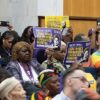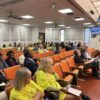May 5, 2001. The Richmond Times Dispatch.
An organization aimed at bringing Richmond area congregations together to attack local social justice problems is being formed.
The organization will not just identify problems and work to alleviate them, it will also concentrate on building interfaith and interracial relationships.
Dr. Martin P. Beifield Jr., senior rabbi at Congregation Beth Ahabah, said: “This will never work unless we can call each other on the telephone and talk about something important. It will only work after we create relationships. It’s part of this greater religious enterprise of translating the great words of scripture into deeds.”
Beifield and the Rev. Kenneth E. Dennis Sr., pastor of Greater Mount Moriah Baptist Church, are co-chairmen of the executive committee of the new organization, Richmond Interfaith Sponsoring Committee.
The organization is not just for clergy, it is for congregations, Dennis said.
A meeting, open to anyone interested in learning about the committee, will be held May 19 from 4 to 5:30 p.m. at Greater Mount Moriah, 913 N. First St.
The Richmond group is affiliated with Direct Action and Research Training, a Miami-based national network with community organizations in six states. DART helps organize the community groups.
DART has organized groups in Michigan, Indiana, Ohio, Kentucky and Florida.
A small group of area clergy started meeting in June to get Richmond’s committee off the ground and to interest congregations in joining, Dennis said.
“Through this organization, congregations work together to meet needs of the community rather than each one working on their own,” he added.
A dozen congregations, representing about 18,000 people, have already affiliated with the effort. In addition to Beth Ahabah and Greater Mount Moriah, these include Second Presbyterian and St. Paul’s Episcopal, both downtown; Eastminster Presbyterian in the East End; New Deliverance Evangelistic and Bon Air Presbyterian, both in Chesterfield County; and Faith Community Baptist in Henrico County.
The cost of affiliating with the committee is based on the size of the congregation. The organization also has applied for private grants. It will not accept government money because it might have to confront government officials in addressing problems, Dennis said.
Clergy will not decide which issues the organization will address.
Beifield said: “Our task is to organize. Our congregations will tell us what they think are the social justice issues of their area that they want us to address. We want our members to tell us what it is that will improve their sense of well-being in Richmond.”
Dennis added: “We will demand change and offer some solutions.”
Because of the concentration of services in the city, people needing the services tend to migrate to Richmond, Beifield said. The problems, however, are not restricted to Richmond – they are regional issues concerning surrounding counties.
A DART organization was started almost five years ago in Columbus, Ohio. Called BREAD, which stands for Building Responsibility, Equality and Dignity, it has 43-member congregations representing Jews, Pentecostals, Baptists, Lutherans and Catholics, said the Rev. John Aeschbury, lead organizer and a United Church of Christ minister.
“We come together not to talk but to take action,” Aeschbury said. Through the group’s efforts, Columbus committed $13.5 million to spur the creation of affordable housing. Now, the group is trying to get nearby Franklin County to contribute.
BREAD also worked for four years on poverty and job issues, Aeschbury said. The poorest people live in the center city, and the jobs are in the suburbs. In 1998, the transit authority in Columbus added 38,000 hours of bus service.
The group’s work isn’t always easy, Aeschbury said. Politicians are not used to being held accountable by the community, and there has been some tension between the group and city government officials, he said.
“But whenever there’s movement, there’s going to be friction,” he added.





